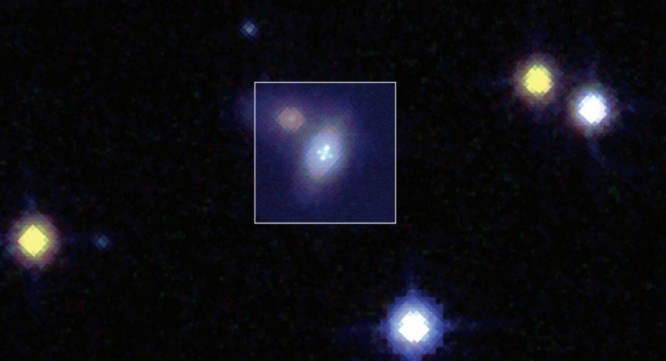An incredible spectacle in and of itself, a supernova is the violent and dramatic explosion of a massive star.
However, astronomers have obtained a picture that is even more remarkable; it is a distorted representation of a supernova, the light of which was significantly bent by the gravity of another galaxy.
Fascinatingly, its light was so distorted that it gave the impression of being split into several other pictures in the sky.
According to Stockholm University, the supernova has been given the moniker SN Zwicky, and it was spotted by the Zwicky Transient Facility (ZTF) at the Palomar Observatory in California.

An phenomenon known as gravitational lensing was responsible for the image’s distortion. This takes place when the mass of an item behind it causes the light from the thing in front of it to warp and become more intense.
Powerful lensing may multiply and amplify distant light.
It is interesting to note that Albert Einstein made a prediction about this phenomenon more than a century ago. In accordance with Einstein’s theory of relativity, if an enormously large object such as a galaxy is present, it has the potential to distort the fabric of space and time that surrounds it.
This warped space-time fabric has the potential to operate as a lens, refracting and focusing the light that is coming from an object that is located behind the galaxy from our point of view.
In the event that this lensing becomes extremely powerful, the light coming from the faraway object may become so distorted that it will be amplified and divided into a large number of copies of the same picture.
Since 1919, observations of this gravitational lensing effect have been made for a variety of cosmic objects. Even with the use of these gravity lenses, however, it is extremely challenging to find supernovae since they only exist for a brief amount of time in the grand scheme of things.
According to Caltech, there have only been a few supernovae that have been seen in such a state, despite the fact that scientists have found lensed duplicated pictures of quasars (an active galactic center fueled by a supermassive blackhole).
The supernova known as SN Zwicky has been identified as a Type Ia supernova, which is a subtype of supernova that occurs in stellar systems comprised of two stars that circle one another. The brightness of a type Ia supernova will often remain consistent from event to event.
It is interesting to note that the accelerated expansion of the universe was demonstrated by employing Type Ia supernovae, as stated by the Department of Energy in the United States.
Because they are amplified, Type Ia supernovae that have been strongly lensed give us the ability to view further back in time.
According to Joel Johansson, co-author of a research on the supernova that was published in Nature Astronomy, “observing more of them will give us an unprecedented opportunity to explore the nature of dark energy.”
This was said in a press statement. The position that Johannson has at Stockholm University is that of a postdoctoral fellow.
SN Zwicky is the smallest resolved gravitational lens system that was detected using optical telescopes, according to Ariel Goobar, who conducted the investigation.

